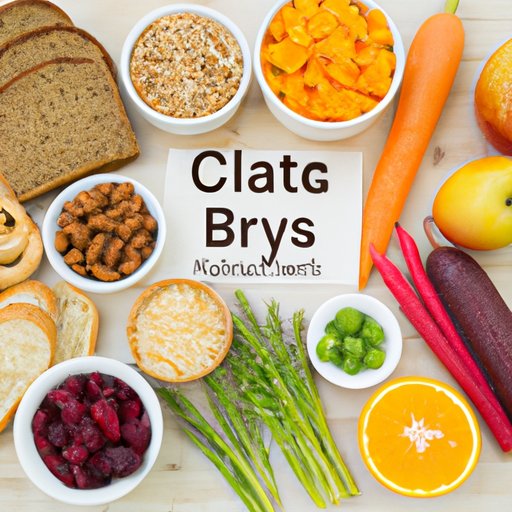Introduction
Carbohydrates are essential macronutrients that provide energy and fuel to our bodies. With so many different types of carbohydrates out there, it can be difficult to know which ones to choose. In this article, we’ll explore what is considered a healthy carb, the benefits of eating healthy carbs, and how to incorporate them into your diet.

Highlighting the Benefits of Healthy Carbs
Eating healthy carbs provides numerous health benefits. Here are some of the most noteworthy:
- Improved Energy Levels: Healthy carbs provide sustained energy levels throughout the day. They also help reduce fatigue and increase physical endurance. According to a study published in Nutrients, “The intake of complex carbohydrates increases the availability of glucose for energy production in the body, leading to improved physical performance.”
- Increased Fiber Intake: Eating healthy carbs helps increase your dietary fiber intake. Dietary fiber is important for promoting digestive health, preventing constipation, and regulating blood sugar levels. It has also been linked to a lower risk of heart disease, stroke, and type 2 diabetes.
- Lower Risk for Disease: Eating healthy carbs may help reduce the risk of certain diseases. A study published in The American Journal of Clinical Nutrition found that higher intakes of dietary fiber were associated with a lower risk of cardiovascular disease and total mortality.

Examining What is Considered a Healthy Carb
When it comes to choosing healthy carbs, it’s important to understand the difference between complex and simple carbohydrates. Complex carbohydrates are found in whole grains, legumes, and starchy vegetables, while simple carbohydrates are found in sweets, pastries, and processed foods. Complex carbohydrates are generally considered to be healthier because they provide more vitamins, minerals, and fiber than simple carbohydrates.
Another factor to consider when selecting healthy carbs is the glycemic index (GI) and glycemic load (GL). The GI is a measure of how quickly a food raises your blood sugar levels after eating it. Foods with a low GI (55 or less) are considered to be “low glycemic” and are generally healthier options. The GL is a measure of how much the food will raise your blood sugar levels. Foods with a low GL (10 or less) are considered to be “low glycemic” and are generally healthier options.
Comparing Unhealthy vs. Healthy Carbs
It’s important to distinguish between unhealthy and healthy carbs. Unhealthy carbs are usually found in processed and refined foods such as white bread, white rice, and sugary snacks. These foods have been stripped of their natural nutrients and fiber, and can cause spikes in blood sugar levels. On the other hand, healthy carbs are found in whole grains, legumes, fruits, and vegetables. These foods are packed with vitamins, minerals, and fiber, and can help maintain steady blood sugar levels.

Exploring Different Types of Healthy Carbs
Here are some of the most common types of healthy carbs:
- Whole Grains: Whole grains are unprocessed grains that contain all three parts of the grain – the bran, germ, and endosperm. Examples include oats, brown rice, quinoa, barley, and buckwheat. Eating whole grains has been linked to a lower risk of heart disease, obesity, and type 2 diabetes.
- Legumes: Legumes are a type of plant-based protein that includes beans, lentils, and peas. They are an excellent source of fiber, protein, and other vitamins and minerals. Studies have shown that eating legumes can help reduce cholesterol levels, improve blood sugar control, and promote weight loss.
- Fruits and Vegetables: Fruits and vegetables are naturally low in calories, fat, and sugar, and high in vitamins, minerals, and fiber. Eating a variety of fruits and vegetables can help reduce the risk of chronic diseases such as heart disease and cancer.
Creating a Shopping List for Healthy Carbs
If you’re looking to add more healthy carbs to your diet, here’s a quick shopping list of some of the best options:
- Whole Grains: Oats, brown rice, quinoa, barley, buckwheat, bulgur, millet, and rye.
- Beans, Lentils, and Peas: Kidney beans, black beans, chickpeas, split peas, lentils, edamame, and green peas.
- Fruits and Vegetables: Apples, oranges, bananas, pears, berries, carrots, spinach, kale, broccoli, cauliflower, potatoes, sweet potatoes, squash, and tomatoes.
Recipes Featuring Healthy Carbs
Now that you know what to shop for, here are some delicious recipes featuring healthy carbs:
- Breakfast Ideas: Overnight oats, savory quinoa porridge, banana oat pancakes, and egg and vegetable breakfast burritos.
- Lunch Ideas: Quinoa salad, roasted vegetable wrap, chickpea and avocado sandwich, and veggie burger.
- Dinner Ideas: Vegetable stir fry, black bean tacos, lentil bolognese, and roasted vegetable quinoa bowl.
Conclusion
Eating healthy carbs can provide numerous health benefits, including improved energy levels, increased fiber intake, and a lower risk for disease. When choosing healthy carbs, it’s important to understand the difference between complex and simple carbohydrates, as well as the glycemic index and glycemic load. Healthy carbs can be found in whole grains, legumes, fruits, and vegetables. To make it easier to incorporate healthy carbs into your diet, create a shopping list of the best options, and try some of the delicious recipes featured in this article.
(Note: Is this article not meeting your expectations? Do you have knowledge or insights to share? Unlock new opportunities and expand your reach by joining our authors team. Click Registration to join us and share your expertise with our readers.)
